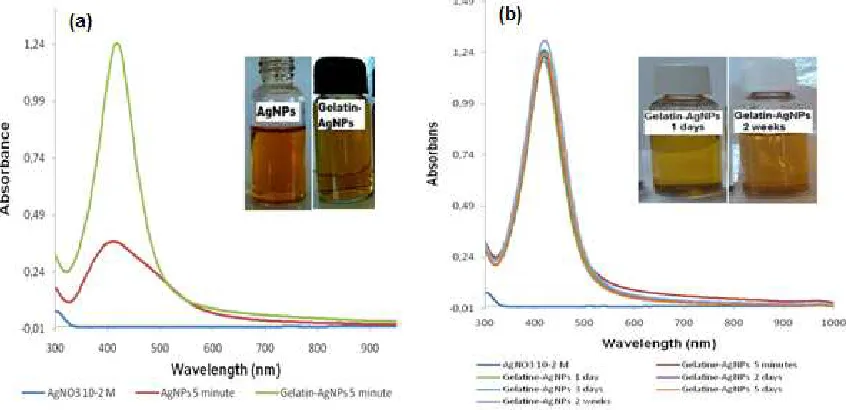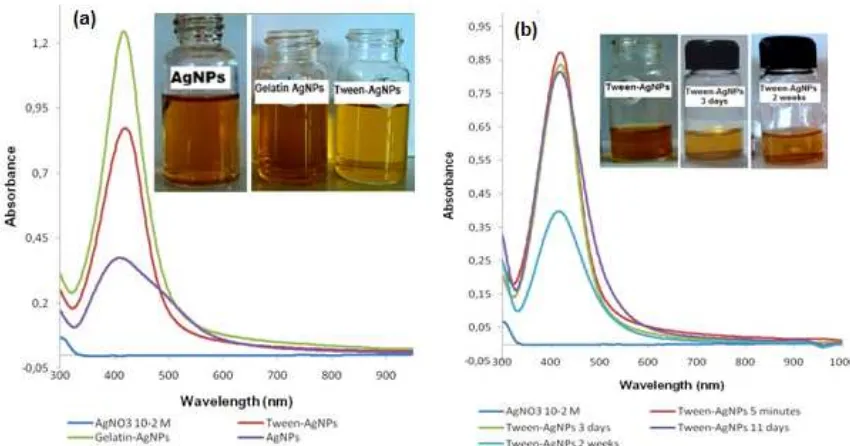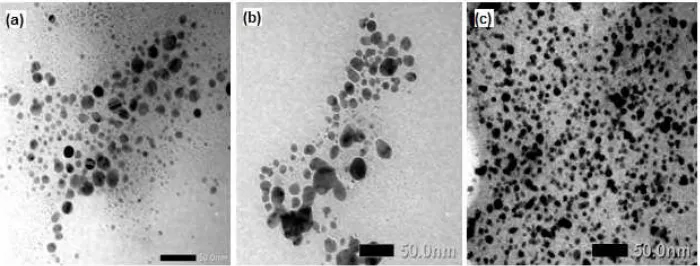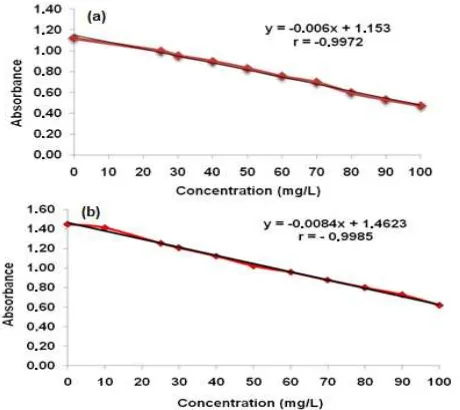Indones. J. Chem., 2015, 15 (1), 1 – 8
1
DETECTION OF Hg
2+METAL IONS USING SILVER NANOPARTICLES STABILIZED BY
GELATIN AND TWEEN-20
Lilis Sulistiawaty
1,2, Sri Sugiarti
1,*, and Noviyan Darmawan
1 1Department of Chemistry, Faculty of Mathematics and Natural Sciences, Bogor Agricultural University, Kampus IPB Darmaga, Jl. Agatis Wing 2 Level 4, Bogor 16144, Indonesia
2
Department of Analysis Instrumentation, Academy Analytical of Chemistry, Jl. Pangeran Sogiri 283, Tanah Baru-Bogor Utara, 16154, Indonesia
Received January 14, 2015; Accepted February 16, 2015
ABSTRACT
Silver nanoparticles were synthesized by reduction method using glucose as reducing agent for precursor AgNO3. This research was aimed at comparing the stability and performance of silver nanoparticles with stabilizer gelatin (Gelatin-AgNPs) and tween-20 (Tween-AgNPs) produced from the synthesis to the silver nanoparticles without stabilizer, and applying the Gelatin-AgNPs and Tween-AgNPs to detect heavy metal in water sample. The silver nanoparticles produced were characterized using UV-Vis spectrophotometer and Transmission Electron Microscopy (TEM). From measurement of UV-Vis spectrophotometer, the absorbance wavelength of silver nanoparticles (AgNPs) appeared in range 411 nm, Gelatin-AgNPs in 417 nm, and Tween-AgNPs in 420 nm. The identification using TEM showed the average size for each AgNPs, Gelatin-AgNPs, and Tween-AgNPs was 11.73, 9.68, and 17.54 nm, respectively. The result showed that Gelatin-AgNPs has better stability compared to Tween-AgNPs. The reaction of AgNPs and Tween-AgNPs with several ions showed color changes of Gelatin-AgNPs and Tween-Gelatin-AgNPs occurred only on addition to Hg2+metal ions solution. Based on the experiment of Hg2+ metal ions determination this method has limit of detection of 0.45 mg/L for Gelatin-AgNPs and 0.13 mg/L for Tween-AgNPs.
Keywords:silver nanoparticles; glucose; gelatin; tween-20
ABSTRAK
Telah dilakukan sintesis nanopartikel perak dengan metode reduksi menggunakan glukosa sebagai agen pereduksi untuk prekursor AgNO3. Penelitian ini bertujuan untuk membandingkan kestabilan dan kinerja nanopartikel perak dengan penstabil gelatin (Gelatin-AgNPs) dan tween-20 (Tween-AgNPs) hasil sintesis terhadap nanopartikel perak tanpa penstabil, dan mengaplikasikan Gelatin-AgNPs dan Tween-AgNPs untuk mendeteksi logam berat dalam contoh air. Nanopartikel perak yang dihasilkan dikarakterisasi menggunakan spektrofotometer UV-Vis dan Transmission Electron Microscopy (TEM). Dari hasil pengukuran spektrofotometer UV-Vis serapan panjang gelombang nanopartikel perak (AgNPs) muncul pada kisaran 411 nm, Gelatin-AgNPs adalah 417 nm dan Tween-AgNPs adalah 420 nm. Identifikasi ukuran dengan TEM menunjukkan rata-rata ukuran untuk AgNPs, Gelatin-AgNPs, dan Tween-AgNPs berturut-turut adalah 11,73, 9,68 dan 17,54 nm. Hasil penelitian menunjukkan Gelatin-AgNPs memiliki stabilitas yang lebih baik daripada AgNPs. Reaksi Gelatin-AgNPs dan Tween-AgNPs dengan sederet ion logam menunjukkan perubahan warna Gelatin-Tween-AgNPs dan Tween-Tween-AgNPs hanya terjadi saat ditambahkan pada larutan ion logam Hg2+. Berdasarkan percobaan penentuan ion logam Hg2+dengan metode ini memiliki limit deteksi 0,45 mg/L untuk Gelatin-AgNPs dan 0,13 mg/L untuk Tween-AgNPs.
Kata Kunci:nanopartikel perak; glukosa; gelatin; tween-20
INTRODUCTION
The synthesis methods, stabilization and characterization of silver nanoparticles have been the subject of much research in recent years. Silver nanoparticles have been used in many applications such as catalysts, biosensors, and in electronics and optics.
Indones. J. Chem., 2015, 15 (1), 1 – 8
2
temperature, in addition to concentration of chemicals, are important in controlling the shape and size of the nanoparticles [2].
The main problem in silver nanoparticle synthesis is the agglomeration and the damage of colloidal system due to precipitation and flocculation. Silver nanoparticles can aggregate and grow continuously if not covered by a capping agent. This problem can be solved by adding a stabilizing agent. The materials most commonly used as stabilizing agents are ligands and polymers with certain affinity to the metal and with specific solubility in the solvents. Polymers can be used to maintain nanoparticle stability by preventing oxidation, agglomeration, and precipitation [3]. Polymers are commonly used as stabilizers because of their non-toxic and biocompatibility properties, for example polyalanine [4], polyacrylonitrile [5-6], cellulose [7], gelatin, and starch [8]. As stabilizers, polymers are effective at chelating Ag+ ions and preventing Ag agglomeration [2] and polymers with OH-groups accelerate the formation of metal nanoparticles, such as of silver and copper [9].
Polyoxyethylene-20 sorbitan monolaurate or tween-20 is a non-ionic hydrophobic surfactant which functions as an emulsifier, solvent, and wetting agent. Previous researchers have used tween-20 as a stabilizer of gold nanoparticles [10], because it is able to act as a surfactant due to its hydrophilic and hydrophobic groups. However, there is no report on the use of tween-20 as a stabilizer of silver nanoparticles.
Gelatin can stabilize the surface of particles by formation of steric barriers [11-12]. The surface properties are based on side chains of gelatin that have non-charged groups and at specific parts of the collagen strain have hydrophobic and hydrophilic amino acids. The hydrophobic and hydrophilic parts can change on the surface, which reduces the solution surface tension. At the same time, gelatin has properties of protecting the surface stability. The use of gelatin for the synthesis of silver nanoparticles has been reported many times. However, we are not aware of any reports on the use of gelatin and silver nanoparticles for the detection of metal ions.
The aspects of chemical synthesis of silver nanoparticles studied in this research are the use of microwave heating techniques, the use of glucose as reducing agent, and the use of gelatin and tween-20 as stabilizers. Optimum experimental conditions were used to study the stability and performance of silver nanoparticles synthesized with gelatin and tween-20 compared with silver nanoparticles without stabilizer. Gelatin-AgNPs and tween-AgNPs were then tested as sensors for heavy metal ions. Based on the HSAB theory the Ag+ ions of AgNO3 have properties of soft
acids, and thus more compatible if used with tween-20 as stabilizer because of its properties as a soft base.
EXPERIMENTAL SECTION
Materials
Materials used were AgNO3 (Merck), Tween-20
(Merck), Gelatin (Merck), Anhydrous glucose (Merck), stock solutions of Hg2+, Mn2+, Zn2+, Cu2+, Fe2+, Cr3+, and Pb2+ at the concentration of 1000 mg/L, HNO3
(p.a). All aqueous solutions were prepared using double distilled water. All reagents used were of analytical grade.
Instrumentation
The synthesized AgNPs, Gelatin-AgNPs and Tween-AgNPs were characterized using Ultraviolet-Visible spectroscopy, and transmission electron microscopy. The UV-Vis spectra were recorded over the range 200-1100 nm with a UV-Vis spectrophotometer (1700 UV-Vis Shimadzu). The TEM observations were carried out using JEM-1400 JEOL 120kV.
Procedure
Synthesis of AgNPs, Gelatin-AgNPs, and Tween-AgNPs
Silver nanoparticles were synthesized with and without addition of stabilizer by reacting 8 mL of AgNO3
10-2 M with 7 mL glucose 0.5 M, and heating in microwave at power 80, which is equal to 75-85 °C, for 15 min and stirring the mixture using magnetic stirrer for 3 h. The stabilizing agent treatment was prepared by adding 0.5 mL of gelatin 0.5% (w/v) or 0.5 mL of tween-20 3% (v/v). Formation of AgNPs with or without stabilizing agent was shown by the color changes of solution from colorless to brownish-yellow.
Colorimetric detection of single metal Ion by Gelatin-AgNPs and Tween-AgNPs
To investigate the metal ions (Hg2+, Mn2+, Zn2+, Cu2+, Fe2+, Cr3+, and Pb2+) detection ability of Gelatin-AgNPs and Tween-Gelatin-AgNPs, each metal ion solution at the same condition and concentration (1 mL, 1000 mg/L) was added to Gelatin-AgNPs and Tween-AgNPs solution (2 mL), respectively. The changes in the UV-Vis absorption spectra were performed and monitored at room temperature. The photographs were taken with a digital camera after 5 min of mixing.
General procedure for the colorimetric determination of Hg2+
Indones. J. Chem., 2015, 15 (1), 1 - 8
3
Fig 1.Spectrum UV-Vis AgNPs and visual observation on AgNPs synthesis process (a) and stability of AgNPs (b)
Fig 2.Spectrum UV-Vis of synthesis gelatin-AgNPs (a) and stability of Gelatin-AgNPs (b)
RESULT AND DISCUSSION
Synthesis and Characterization Silver Nanoparticles (AgNPs)
Silver nanoparticles (AgNPs) were formed through reduction oxidation reaction of Ag+ ions of AgNO3
solution. During reduction, there was the addition of electrons that made the charged Ag+ ions change to uncharged (Ag0) [13]. The formation of AgNPs was marked with color changes of the solution from colorless to brownish yellow [10,11,13] and also marked with the appearance of absorbance peak at 400-530 nm on UV-Vis spectrum [15], it was showed the number of AgNPs produced and the progress of the reaction over time.
The characterization of AgNPs using UV-Vis spectrum showed that there was an absorbance peak at
408-413 nm (Fig. 1a). The size of AgNPs can be predicted based on wavelength of maximum absorbance. Silver nanoparticles with maximum absorbance wavelength of 405-416 have particle size between 20-40 nm [16]. Based on size analysis employing TEM, in this study the AgNPs formed have particle size of 15.37 nm. This result is different from the works done by Solomon et al. (2007), perhaps because of the difference in experimental conditions where the reducing agent used was NaBH4, and the
Indones. J. Chem., 2015, 15 (1), 1 - 8
4
Fig 3.Spectrum UV-Vis synthesis Tween-AgNPs (a) and stability of Tween-AgNPs
formation of more homogenous nucleation and shorter crystallization time compared to conventional heating [17-18]. AgNPs stability can be assessed by observing the UV-Vis spectrum changes of the AgNPs solution over time. Fig. 1b shows the absorbance after 5 min, 1 day, and 2 days AgNPs. The absorbance values show that the AgNPs were not stable and were easily agglomerated. This could be observed visually as the color of the solution changed from brownish yellow to colorless.
Silver Nanoparticles (AgNPs) Modification using Gelatin 0.5% as Stabilizer (Gelatin-AgNPs)
Surface modification or nanoparticle colloidal coverings are thought to stabilize the nanoparticles and to prevent aggregation [19]. In this research the stabilization of AgNPs was done by steric stabilization with gelatin due to its biocompatibility properties and because it is biodegradable. Gelatin has amine groups (NH2) in its backbone that are able to bond with Ag. The
chemical reaction suggested for this process is given in the equation:
After dispersion of silver ions in gelatin matrix (Eq. 1) [10], gelatin capped the Ag+to form a stable gelatinous complex [Ag(gel)]+(Eq. 2) [20].
The color of the gelatin-AgNPs solution during reaction changed from colorless to brownish yellow and had maximum absorbance at wavelength of 416 nm
(Fig. 2a). The absorbance spectrum of the Gelatin-AgNPs was higher and more symmetrical compared to the AgNPs, which showed that there was a higher number of the silver nanoparticles formed in the gelatin treatment and that there was more homogeneity in particle size. However the maximum wavelength was not shifted, and was between 413 nm and 416 nm. Observation on the stability of Gelatin-AgNPs showed that the absorbance value of Gelatin-AgNPs did not decrease and there was no shift in wavelength, staying
at λmax 419 nm (Fig. 2b). This shows that employing
gelatin increased the stability of the nanoparticles, probably because the AgNPs were covered sterically by gelatin and thus was prevented from agglomerating.
Silver Nanoparticles Modification using Tween-20 as Stabilizer (Tween-AgNPs)
AgNPs modification using surfactant tween-20 was done to observe its ability to prevent aggregation of the nanoparticles. The formation of silver nanoparticles modified by tween-20 (Tween-AgNPs) was marked by color changes from colorless to pale yellow. Characterization using UV-Vis
spectrophotometer gave λmax at 420 nm, a different
Indones. J. Chem., 2015, 15 (1), 1 - 8
5
Fig 4. TEM image of AgNPs (a) Tween-AgNPs (b) Gelatin-AgNPs (c)
Fig 5. Metal ions detection using Gelatin-AgNPs (a) and Tween-AgNPs (b)
is a ligand with valence electrons easily polarized by other outside ions. According to the HSAB theory (Hard Soft Acid Base), soft acids usually prefer to coordinate with soft bases. Based on the previous explanation, the nanoparticles covered with tween-20 should give absorbance values rather close to the absorbance value given by nanoparticles covered by gelatin, however in fact those values were different which means there were other factors affecting this synthesis process, one of the factors that can be proposed is a lower stability of tween-20 to heat caused by microwave than that of gelatin. However, no optimation experiment was conducted for the Tween-AgNPs synthesis. Tween-AgNPs is less stable compared to Gelatin-AgNPs, this is shown by its gradually decreasing absorbance value. It was also seen from visual observation, that the solution of Tween-AgNPs became colorless after 2 weeks, presumably because there was aggregation and decomposition (Fig. 3b).
Characterization of AgNPs, Gelatin-AgNPs, and Tween-AgNPs using TEM
The shape and size of nanoparticles affect their potential applications and uses. TEM measurements of
the AgNPs, Gelatin-AgNPs, and Tween-AgNPs are shown in Fig. 4. The TEM image shows that silver nanoparticles produced from synthesis are round in shape. Based on TEM measurement the size of Gelatin-AgNPs is smaller compared to Tween-AgNPs and AgNPs, and its size distribution is more homogenous. It is not known why the size of gelatin-AgNPs is smaller than the other silver nanoparticles, but perhaps it is related to the rate of reduction reaction which is influenced by the type of stabilizer used, or also due to the difference critical micelle concentration (CMC) value of gelatin and tween-20. The average particle size of Tween-AgNPs is 17.54 nm, Gelatin-AgNPs is 9.68 nm, and Gelatin-AgNPs is 11.73 nm. These numbers show that glucose is effective as a reducing agent to produce small particle sizes.
Colorimetry Detection of Single Metal Ion
Indones. J. Chem., 2015, 15 (1), 1 - 8
6
Fig 6. Visual observation of Hg2+metal ions detection by Gelatin-AgNPs (a) and Tween-AgNPs (b)
Fig 7. Absorbance change of Gelatin-AgNPs (a) and Tween-AgNPs (b) at various Hg2+concentration
Fig 8. Calibration curve of Gelatin-AgNPs at max 386 nm (a) and Tween-AgNPs atmax 392 nm (b)
with Gelatin-AgNPs and Tween-AgNPs, the Hg2+metal ions solution was changed from brownish yellow to cloudy then to colorless in less than a minute. On the other hand, the Cr3+ metal ions solution was changed when mixed with Gelatin-AgNPs from brownish yellow to orange in 1 min, while for Mn2+and Fe2+that change took more than 1 min. Color change occurred because of aggregation between silver nanoparticles with analytes [21]. The ability of silver nanoparticles to form aggregates caused the SPR (Surface Plasmon Resonance) to broaden and shift to longer wavelength.
Indones. J. Chem., 2015, 15 (1), 1 - 8
7
Table 1.Detection limit of Hg2+determination using Gelatin-AgNPs and Tween-AgNPs
Absorbance
Repetition Gelatin-AgNPs + Double
distilled water
LoD 0.45 mg/L 0.13 mg/L
Table 2. Recovery (in acuration test) of Hg2+determination using Gelatin-AgNPs
Water sample Water sample + Spike
Repetition
Abs Conc (mg/L) Abs Conc (mg/L)
Conc Spike
1 1.085 -1.00 0.760 45.43 50 46.43 92.86
2 1.087 -1.29 0.766 44.57 50 45.86 91.71
3 1.085 -1.00 0.773 43.57 50 44.57 89.14
4 1.086 -1.14 0.773 43.57 50 44.71 89.43
5 1.086 -1.14 0.775 43.29 50 44.43 88.86
6 1.084 -0.86 0.776 43.14 50 44.00 88.00
7 1.084 -0.86 0.776 43.14 50 44.00 88.00
Average 1.085 -1.04 0.771 43.82 50.00 44.86
Acceptable value % Recovery : 85-115%
Table 3.Recovery (in acuration test) of Hg2+determination using Tween-AgNPs
Water sample Water sample + Spike
Repetition
Abs Conc (mg/L) Abs Conc (mg/L)
Conc Spike
1 1.458 0.51 1.050 49.08 50 48.57 97.14
2 1.454 0.99 1.051 48.96 50 47.98 95.95
3 1.456 0.75 1.050 49.08 50 48.33 96.67
4 1.456 0.75 1.050 49.08 50 48.33 96.67
5 1.456 0.75 1.050 49.08 50 48.33 96.67
6 1.458 0.51 1.049 49.20 50 48.69 97.38
7 1.458 0.51 1.048 49.32 50 48.81 97.62
Average 1.457 0.68 1.050 49.12 50.00 48.44
Acceptable value % Recovery : 85-115 % of 50 mg/L (Fig. 6a). Whereas Tween-AgNPs proved
more sensitive and still showed a shift of SPR from 412 nm to 392 nm when the concentration of Hg2+was only 25 mg/L (Fig. 6b). However these results differed from those done by visual observations, as seen in Fig. 7. The minimum concentration of Hg2+ ions for qualitative visual detection was 150 mg/L.
The limit of detection for Hg2+ by the UV-Vis spectrophotometer method was 0.45 mg/L for Gelatin-AgNPs and 0.13 mg/L for Tween-Gelatin-AgNPs (Table 1). It means the lowest concentration of analyte in the sample with acceptable precision and accuracy level. Based on linearity measurement for this method, the equation obtained for Gelatin-AgNPs was y = -0.0067x + 1.1531 with r = -0.9972 (Fig. 8a). While the linear equation for TweenAgNPs was y = 0.0084x + 1.4623 with r = -0.9985 (Fig. 8b). All of the linear equation showed the
higher concentration of Hg2+ caused the lower asorbance level.
Indones. J. Chem., 2015, 15 (1), 1 – 8
8
method has high accuracy (test result is close to the actual value), meaning this method is an accurate way to detect Hg2+ metal ions in water samples. Measurement results can be found in Table 2 and Table 3.
CONCLUSION
Gelatin performs better than tween-20 as a stabilizer in silver nanoparticles synthesis. Gelatin-AgNPs have higher stability, and are more homogenous in particle size distribution. Gelatin-AgNPs and Tween-AgNPs can be used as sensors to detect the presence of Hg2+ metal ions presence in water, using the colorimetric method to detect wavelength shifts and reduction in absorbance values. Determination of the instrument’s limit of detection (LoDI) showed suitably low
values at 0.45 mg/L for Gelatin-AgNP and 0.13 mg/L for Tween-AgNPs. Precision test gave %RSD 1.97 (Gelatin-AgNPs) and %RSD 0.23 (Tween-(Gelatin-AgNPs), and accuracy test’s result gave %recovery values of 88.00%–92.86% (Gelatin-AgNPs) and 95.95–97.67% (Tween-AgNPs). Linear working area, low detection limit, high stability, precision, and accuracy showed that Gelatin-AgNP and Tween-AgNPs have potential as a cheaper and more accurate alternatives for application as sensors in the future.
ACKNOWLEDGEMENT
The authors would like to acknowledge The Ministry of Science, Department of Chemistry, Faculty of Mathematics and Natural Sciences, Bogor Agricultural University, and Academy Analytical of Chemistry for the laboratory facilities.
REFERENCES
1. Tolaymat, T.M., El-Badawy, A.M., Genaidy, A., Sheckel, K.G., Luxton, T.P., and Suidan, M., 2010, Sci. Total Environ., 408(5), 999–1006
2. Anna Zielińska, A., Skwarek, E., Zaleska, A., Gazda,
M., and Hupka, J., 2009, Procedia Chem., 1(2), 1560–1566.
3. Li, H., and Bian, Y., 2009, Nanotechnology, 20(14), 145502–145507.
4. Khanna, P.K., Singh, N., Charan, S., and Viswanath, A.K., 2005,Mater. Chem. Phys., 92(1), 214–219. 5. Zhang, J.P., Sheng, L.Q., and Chen, P, 2003,Chin.
Chem. Lett., 14(6), 645–648.
6. Zhang, Y., Yang, D., Kong, Y., Way, X., Randoli, O., and Gao, G, 2010, Nano Biomed. Eng., 2(4), 252–257.
7. Cai, J., Kimura, S., Wada, M., and Kuga, S, 2009, Biomacromolecules, 10(1), 87–94.
8. Raveendran, P., Fu. J., and Wallen, S.L., 2003,J. Am. Chem. Soc., 125(46), 13940–13941.
9. Singh, C., Baboota, R.K., Naik, P.K., and Singh, H, 2012,Adv. Mater. Lett., 3(4), 279–285.
10. Roh, J., Shim, J., Kim, Y., 2011, Colorimetric detection of metal ions with tween coated gold nanoparticle, Proceeding on the 18th International Conference on Composite Materials, 21-26 August, South Korea.
11. Darroudi, M., Ahmad, M., Abdullah, A.H., Ibrahim, N.A., and Shameli, K, 2010, Int. J. Mol. Sci., 11(10), 3898–3905.
12. Darroudi, M., Ahmad, M., Abdullah, A.H., and Ibrahim, N.A, 2011,Int. J. Nanomed., 6, 569–574. 13. Timberlake, K.C, 2010, General, Organic, and
Biological Chemistry: Structure of Life, 3rd ed., Prentice Hall, New York.
14. Shankar, S.S., Rai, A., Ahmad, A., and Sastry, M., 2004,J. Colloid Interface Sci., 275(2), 496–502. 15. Samberg, M.E., Oldenbrg, S.J, and
Monteiro-Riviere, N.A., 2010, Environ. Health Perspect., 118(3), 407-413.
16. Solomon, S.D., Bahadory, M., Jeyarajasingam, A.V., Rutkowsky, S.A., Boritz, C., and Mulfinger, L., 2007,J. Chem. Educ., 84(2), 322–325.
17. Jiang, H., Moon, K., Zhang, Z., Pothukuchi, S., and Wong, C.P., 2006, J. Nanopart. Res., 8(1), 117– 124.
18. Jiang, Z.L., Feng, Z.W., and Shen, X.C, 2001, Chin. Chem. Lett., 12(6), 551–554.
19. Alexandridis, P., 2011, Chem. Eng. Technol., 34(1), 15–28.
20. Oluwafemi, O.S., Lucwaba, Y., Gura, A., Masabeya, M., Ncapayi, V., Olujimi, O.O., and Songca, S.P, 2013, Colloids Surf., B, 102, 718– 723.
21. Xiong, D., and Li, H, 2008, Nanotechnology, 19(46), 465502-465507.



